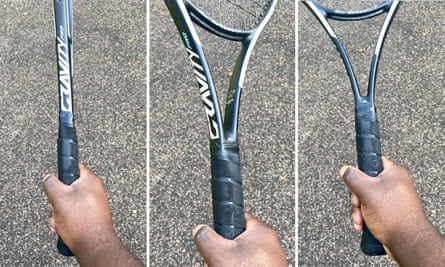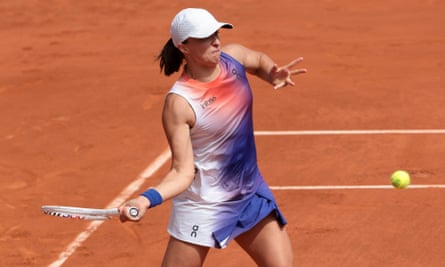In her short time on the WTA tour, Iga Swiatek has quickly established herself as one of the greatest players of the new generation. Her success, which includes four titles in the past five years at the French Open, the same venue at which the Olympic tennis tournament will be held, has been driven by her incredible, destructive forehand.
Swiatek constantly looks to take control of the points with her forehand. The heavy topspin she generates with the stroke forces opponents back behind the baseline, it allows her to create greater angles and it provides more safety with her ball striking.
Greg Rusedski, the former British men’s No 1 and world No 4, identifies Swiatek’s western grip as a key factor in her success with her forehand: “It’s the extreme grip on it,” says Rusedski. “You look at the technique on the shot, also the physicality with the use of the legs and the speed of the arms. It’s a combination of so many factors that make it so, so effective. It’s more effective on the clay courts than any other surface because of the kick and the bounce. If I’d describe it in the men’s game, it’s like Rafael Nadal’s forehand for the women’s game.”
How to copy-cat Swiatek’s forehand
Although more female players are adopting topspin-heavy forehands, even at the highest level of tennis Swiatek’s forehand is so difficult to directly replicate: “Don’t try it yourself at home, that’s how I’d describe it,” says Rusedski, laughing. “It’s something that takes years of practice and also the technique is quite hard on the shoulder and the arm.”

What amateur players can take from Swiatek’s forehand are the many things she does to set up the shot. Hitting with greater topspin does not automatically mean you have to settle for hitting a softer ball. Swiatek uses her immense racket head speed to accelerate through the ball, with the topspin providing more safety and margin on her attacking strokes. As amateur players try to brush up behind the ball and generate more topspin, they should not feel inclined to decelerate. “What [the topspin] does is that it bounces up like a mule,” says Rusedski. “So, in other words, you can dip the ball very quickly, you can put rotation so the ball drops quickly, so it’s all those little things. So that’s what makes [the difference].”
Another key aspect of Swiatek’s forehand dominance is her determination to take the ball early and attack. Taking the ball early takes time away from the opponent and it allows her to use the pace that has already been generated by the opponent, deflecting the ball back across the court. Rusedski says the key to taking the ball early is to start your forehand motion as early as possible. “It’s early preparation, getting your knees low,” says Rusedski. “The better you move in our sport, the better you will play. Early preparation helps taking it early.”

Finally, Swiatek is an incredible athlete and her footwork is one of her biggest strengths. Like Swiatek, amateur players should always be looking to take small, consistent steps between strokes to create necessary space between yourself and the ball. Constantly moving can be tiring and it is easy to fall back into lazy habits but using your footwork to create space around the ball is one of the keys to being able to replicate a stroke consistently.
“I think her footwork is exceptional,” says Rusedski. “She’s the best mover in the women’s game. She’s got a great attitude and she’s always looking to get better so there’s so many attributes you can take.”
after newsletter promotion
Three key takeaways
-
Look to generate more topspin by brushing up behind the ball but don’t be afraid to continue accelerating through the stroke
-
Prepare your groundstrokes early so that you have time to step forward inside the baseline and take the ball early in order to attack
-
Work on your footwork, particularly the small, quick steps around the ball so you always have the space to comfortably hit your groundstrokes.


